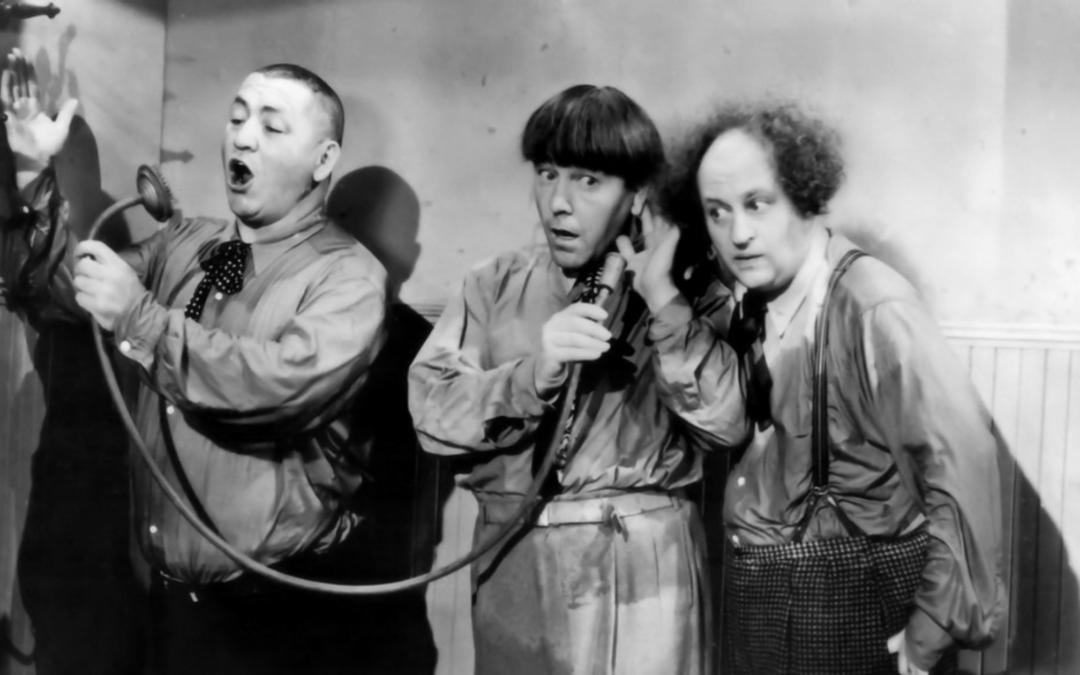History Through Black & White Film: Slapstick Edition
You never know when a history lesson may present itself!
A Family Tradition of Laughter
When I was little, my dad introduced me to the Three Stooges. Our family owned a couple of VHS tapes with collections of old Stooges episodes, which we watched regularly. The Three Stooges’ situational comedy and slapstick humor appealed across generations, making them ideal for family entertainment. They were just funny, and you didn’t need to be of a certain age to recognize it. Granted, not everyone loves slapstick, but I have many fond memories of sitting with my dad on the couch, laughing at Moe dragging Larry around by the hair or the kettledrum sound it made when Curly got thumped in the stomach.
Rediscovering the Three Stooges
When I had kids of my own, I decided to introduce them to the Stooges as well. Of course, they loved the comedy and the slapstick, but I was surprised at the historical interest it engendered. For example, the plot of the 1941 episode An Ache in Every Stake centers on the Stooges as ice delivery men. They stumble into various misadventures while delivering ice in a California town. My kids had so many questions—Were ice delivery men really a thing? Why did people have huge blocks of ice delivered to their houses? Or the 1943 Dizzy Pilots, where the Stooges play a trio of inventors known as the “Wrong Brothers” who claim to have invented a revolutionary new military aircraft and must demonstrate the craft’s utility or else be drafted into the war.
Again, the episode’s historical details prompted interesting questions. Did someone really need to manually start early aircraft propellers by spinning them? Why did they coat the aircraft in a liquefied rubber solution (a practice known as “aircraft doping” that was used to help the craft withstand intense pressure)? Were Americans really just handed government letters notifying them that they had to report for military duty?
Unexpected Historical Lessons from Slapstick Comedy
My experience watching the Three Stooges with my kids demonstrates that older cinema has a metahistorical value above and beyond the intended story. An Ache in Every Stake was not meant to be a historical film. It was just a comic short about ice delivery men’s misadventures. However, it inadvertently documented the ice delivery business. This was a reality for millions of Americans before household freezers were adopted. Like an insect frozen in amber, this short film preserved a now-vanished aspect of our own domestic history.
Metahistorical Value of Older Cinema
We usually think of historical cinema as films set in a historical period, like The Mission, Braveheart, or Lawrence of Arabia. These films were deliberately made to tell historical stories. But historical dramas are not the only type of historical film; given enough time, any piece of cinema will become “historical” just by virtue it reflecting technologies, attitudes, and patterns of life that have long since vanished. In a sense, these films become the visual equivalent of primary source texts. They have a value beyond what they intend to say, a value derived merely from their age and their creation from minds long gone.
Historical Cinema: More Than Just Period Dramas
The takeaway is that revisiting some old black-and-white cinema might be worth it. Do this not just for entertainment but also for historical value. It is easy for me to forget how distant the black-and-white era is; when I was a boy, they were still showing reruns of Andy Griffith and Leave it to Beaver on network television. Since I personally experienced a bit of black and white, I tend to think of it as vintage but not necessarily historical. But each passing year throws that era further into the past. To go back to the Three Stooges, the Stooges debuted in 1930—93 years ago! If Moe Howard were still alive today, he’d be 126 years old.
Embracing the Past Through Classic Films
I’d like to review specific movies or programs in the future that are good for historical study. However, for now, next time it’s a rainy Saturday and you’ve nothing to do, watch an old black-and-white classic with your kids. It’ll be fun to see what they notice about the different ways of life reflected in the cinema. It can make for some interesting historical observations and discussion!
What are some of your favorite old black-and-white films or TV shows? How have they instigated history discussions in your homeschool? Join me and other homeschooling parents at our Homeschool Connections Community or our Facebook group to continue the discussion!






